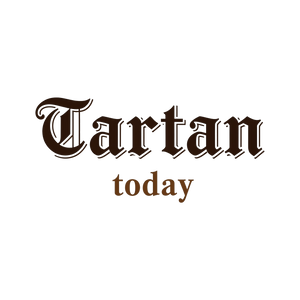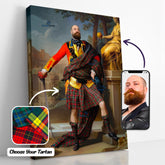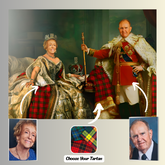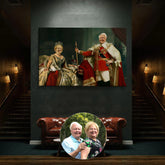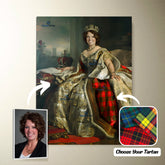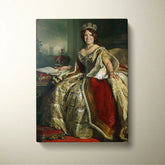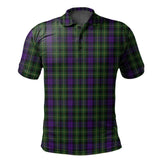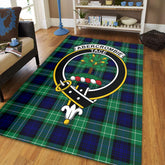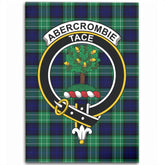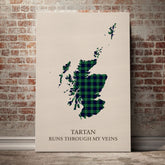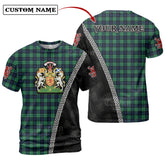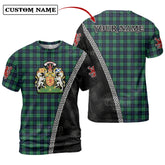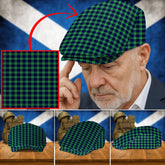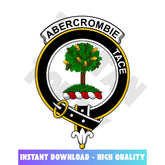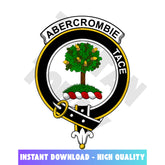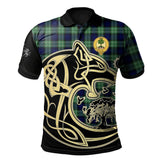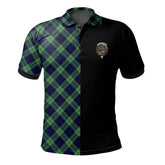-
Personalized Clan Abercrombie Modern Tartan Bagpipe Ornament with Custom Name – Scottish Christmas Tree Decoration ER15
Personalized Clan Abercrombie Modern Tartan Bagpipe Ornament with Custom Name – Scottish Christmas Tree Decoration ER15Celebrate your Scottish heritage with this unique wood & acrylic tartan ornament. Perfect as a personalized Christmas decoration or a meaningful gift for friends and relatives on special occasions...- From $19.99 USD
$25.99 USD- From $19.99 USD
- Unit price
- per
Save $6.00 -
Personalized Clan Abercrombie Ancient Tartan Bagpipe Ornament with Custom Name – Scottish Christmas Tree Decoration EA65
Personalized Clan Abercrombie Ancient Tartan Bagpipe Ornament with Custom Name – Scottish Christmas Tree Decoration EA65Celebrate your Scottish heritage with this unique wood & acrylic tartan ornament. Perfect as a personalized Christmas decoration or a meaningful gift for friends and relatives on special occasions...- From $19.99 USD
$25.99 USD- From $19.99 USD
- Unit price
- per
Save $6.00 -
Clan Abercrombie 02 Tartan Polo Shirt FI71 - Abercrombie 02 Tartan
Clan Abercrombie 02 Tartan Polo Shirt FI71 Description: Crafted in 100% polyester with your own design which combines comfort and vogue. This shirt has some'great features, it has 3 buttons, elastic collar and cuffs. 12.35 Oz. Made from polyester fabric. 3 buttons, elastic collar...- $38.25 USD
- $38.25 USD
- Unit price
- per
-
Abercrombie 02 Tartan
-
Clan Abercrombie Tartan Christmas Ceramic Ornament Highland Cows Style CC54 - Abercrombie Tartan
Clan Abercrombie Tartan Christmas Ceramic Ornament Highland Cows Style CC54 Product Detail:One of the best things about Christmas is that it gives you an excuse to dress up your home with all of the lovely ornaments we associate with the holiday season. With so...- From $14.45 USD
- From $14.45 USD
- Unit price
- per
-
Abercrombie Tartan
-
Personalized Clan Abercrombie Modern Tartan Drummer Ornament with Custom Name – Scottish Christmas Tree Decoration JZ16
Personalized Clan Abercrombie Modern Tartan Drummer Ornament with Custom Name – Scottish Christmas Tree Decoration JZ16Celebrate your Scottish heritage with this unique wood & acrylic tartan ornament. Perfect as a personalized Christmas decoration or a meaningful gift for friends and relatives on special occasions...- From $19.99 USD
$25.99 USD- From $19.99 USD
- Unit price
- per
Save $6.00 -
Personalized Clan Abercrombie Reproduction Tartan Bagpipe Ornament with Custom Name – Scottish Christmas Tree Decoration EL33
Personalized Clan Abercrombie Reproduction Tartan Bagpipe Ornament with Custom Name – Scottish Christmas Tree Decoration EL33Celebrate your Scottish heritage with this unique wood & acrylic tartan ornament. Perfect as a personalized Christmas decoration or a meaningful gift for friends and relatives on special occasions...- From $19.99 USD
$25.99 USD- From $19.99 USD
- Unit price
- per
Save $6.00 -
Personalized Clan Abercrombie Weathered Clan Crest Tartan Santa Ornament – Custom Acrylic Christmas Decoration IR88 - Abercrombie
Personalized Clan Abercrombie Weathered Clan Badge Tartan Ornament – Custom Acrylic Christmas Decoration IR88Celebrate your Scottish heritage with this unique wood & acrylic tartan ornament. Perfect as a personalized Christmas decoration or a meaningful gift for friends and relatives on special occasions such as...- From $19.99 USD
- From $19.99 USD
- Unit price
- per
-
Abercrombie
-
Personalized Clan Abercrombie Modern Clan Crest Tartan Santa Ornament – Custom Acrylic Christmas Decoration SS74 - Abercrombie
Personalized Clan Abercrombie Modern Clan Badge Tartan Ornament – Custom Acrylic Christmas Decoration SS74Celebrate your Scottish heritage with this unique wood & acrylic tartan ornament. Perfect as a personalized Christmas decoration or a meaningful gift for friends and relatives on special occasions such as...- From $19.99 USD
- From $19.99 USD
- Unit price
- per
-
Abercrombie
-
Clan Abercrombie Tartan Rug – Scottish Highland Carpet for Living Room, Celtic Home Decor & Scotland Gift MS37
Clan Abercrombie Tartan Rug – Scottish Highland Carpet for Living Room, Celtic Home Decor & Scotland Gift MS37Bring timeless Scottish charm into your home with our premium Tartan Area Rug. Designed with authentic Scottish tartan patterns, this rug is perfect for adding a touch...- From $58.45 USD
- From $58.45 USD
- Unit price
- per
-
Clan Abercrombie Tartan Crest Rug – Scottish Highland Carpet for Living Room, Celtic Home Decor & Scotland Gift MD11
Clan Abercrombie Tartan Crest Rug – Scottish Highland Carpet for Living Room, Celtic Home Decor & Scotland Gift MD11Bring timeless Scottish charm into your home with our premium Tartan Area Rug. Designed with authentic Scottish tartan patterns, this rug is perfect for adding a...- From $58.45 USD
- From $58.45 USD
- Unit price
- per
-
Custom Name Clan Abercrombie Modern Tartan Garden Flag with Clan Crest and the Golden Sword of Courageous Legacy RL31 - Abercrombie Modern
Custom Name Clan Abercrombie Modern Tartan Garden Flag with Clan Crest and the Golden Sword of Courageous Legacy RL31 Immerse your space in the rich heritage of Scotland with our Tartan Garden Flags, exclusively from Tartan Today. Featuring vibrant tartan and Scottish heritage designs, these...- From $34.45 USD
- From $34.45 USD
- Unit price
- per
-
Abercrombie Modern
-
Clan Abercrombie Modern Tartan Scotland Map Canvas “Tartan Runs Through My Veins” Wall Art JX40
Clan Abercrombie Modern Tartan Scotland Map Canvas “Tartan Runs Through My Veins” Wall Art JX40Celebrate your Scottish heritage with this striking canvas print featuring the map of Scotland filled with Abercrombie Modern tartan, paired with the bold phrase: “Tartan Runs Through My Veins.” Whether...- From $35.05 USD
- From $35.05 USD
- Unit price
- per
-
Personalized Clan Abercrombie Modern Tartan Shirt with Scotland Coat of Arms & Custom Name JH13 - Abercrombie Modern
Abercrombie Modern Tartan Shirt with Scotland Coat of Arms & Custom Name JH13Celebrate your Scottish heritage with this Abercrombie Modern Tartan Shirt with Scotland Coat of Arms & Custom Name JH13, featuring a bold Scotland Coat of Arms and your custom name on the...- From $39.54 USD
- From $39.54 USD
- Unit price
- per
-
Abercrombie Modern
-
-
Tartan
-
-
Clan Abercrombie Modern Tartan Custom Face Hawaiian Shirt – Unisex Gift for Family Members, Summer Party FX76 - Abercrombie Modern Tartan
Clan Abercrombie Modern Tartan Custom Face Hawaiian Shirt – Unisex Gift for Family Members, Summer Party FX76?? Stand out with our custom face Hawaiian shirt featuring your chosen tartan pattern and up to 10 faces printed for free! Whether it's your own, your pet's,...- $42.25 USD
$59.99 USD- $42.25 USD
- Unit price
- per
Save $17.74-
Abercrombie Modern Tartan
-
Clan Abercrombie Modern Tartan Flat Cap GP84 - Clan Abercrombie Modern Tartan
Clan Abercrombie Modern Tartan Flat Cap GP84Elevate Your Heritage: The Authentic Tartan Jeff Cap Step into a legacy of timeless style and comfort with our Authentic Tartan Flat Cap. Crafted for the discerning American who cherishes their Scottish roots and appreciates classic elegance, this isn’t...- From $33.85 USD
$45.59 USD- From $33.85 USD
- Unit price
- per
Save $11.74-
Clan Abercrombie Modern Tartan
-
Clan Abercrombie Tartan Crest, Badges, Heraldry, Clans, Family Scotland PNG, Digital ClipArt High Quality UB62
Clan Abercrombie Tartan Crest, Badges, Heraldry, Clans, Family Scotland PNG, Digital ClipArt High Quality UB62 DIGITAL FILE ONLY* ** This listing is an INSTANT DIGITAL DOWNLOAD, not a physical item. An instant download is a digital file you can download and use immediately **...- $3.49 USD
$5.99 USD- $3.49 USD
- Unit price
- per
Save $2.50 -
Clan Abercrombie Tartan Crest, Badges, Heraldry, Clans, Family Scotland PNG, Digital ClipArt High Quality SY91
Clan Abercrombie Tartan Crest, Badges, Heraldry, Clans, Family Scotland PNG, Digital ClipArt High Quality SY91 DIGITAL FILE ONLY* ** This listing is an INSTANT DIGITAL DOWNLOAD, not a physical item. An instant download is a digital file you can download and use immediately **...- $3.49 USD
- $3.49 USD
- Unit price
- per
-
Clan Abercrombie Tartan Polo Shirt Viking Wolf BC53 - Abercrombie Tartan
Clan Abercrombie Tartan Polo Shirt Viking Wolf BC53 Description: Crafted in 100% polyester with your own design which combines comfort and vogue. This shirt has some'great features, it has 3 buttons, elastic collar and cuffs. 12.35 Oz. Made from polyester fabric. 3 buttons, elastic...- $38.25 USD
- $38.25 USD
- Unit price
- per
-
Abercrombie Tartan
-
Clan Abercrombie Tartan Polo Shirt Half of Me - Cross Style BA24 - Abercrombie Tartan
Clan Abercrombie Tartan Polo Shirt Half of Me - Cross Style BA24 Description: Crafted in 100% polyester with your own design which combines comfort and vogue. This shirt has some'great features, it has 3 buttons, elastic collar and cuffs. 12.35 Oz. Made from polyester...- $38.25 USD
- $38.25 USD
- Unit price
- per
-
Abercrombie Tartan
Ex: Your Tartan + Product
Popular Products
Turn Me Royal Personalized Portrait from Your Photo, Custom Tartan. Custom Canvas Wall Art as Gift for Men
- From $32.45 USD
- From $32.45 USD
- Unit price
- / per
Royalty Couple Personalized Portrait from Your Photo, Custom Tartan. Custom Canvas Wall Art
- From $47.45 USD
- From $47.45 USD
- Unit price
- / per
The Queen Personalized Portrait from Your Photo, Custom Tartan. Custom Canvas Wall Art as Gift for Women
- From $32.45 USD
- From $32.45 USD
- Unit price
- / per
Which Clan Are You From?
- Abercrombie
- Abercrombie (Abercromby) Modern
- Abercrombie 01
- Abercrombie 02
- Abercrombie Ancient
- Abercrombie ClanAbercrombie TartanApron
- Abercrombie ClanAbercrombie TartanPillow Cover
- Abercrombie Modern
- Abercrombie Modern Gnome
- Abercrombie Modern Tartan
- Abercrombie Reproduction
- Abercrombie Tartan
- Abercrombie Tartan Clan
- Abercrombie Weathered
- Badges
- Clan Abercrombie Tartan Crest
- Clans
- Digital ClipArt High Quality SY91
- Family Scotland PNG
- Heraldry
- Scott
- Tshirt 1
List Of Tartan
-
Clan A
- Abercrombie Tartan
- Aberdeen Tartan
- Abernethy Tartan
- Adair Tartan
- Adam Tartan
- Ayrshire Tartan
- Agnew Tartan
- Aikenhead Tartan
- Ainslie Tartan
- Aiton Tartan
- Allan Tartan
- Alexander Tartan
- Allardice Tartan
- Allison Tartan
- Anderson Tartan
- Angus Tartan
- Anstruther Tartan
- Arbuthnot Tartan
- Armstrong Tartan
- Arnott Tartan
- Auchinleck Tartan
- Ayrshire Tartan
-
Clan B
- Baillie Tartan
- Bain Tartan
- Baird Tartan
- Balfour Tartan
- Bannatyne Tartan
- Bannerman Tartan
- Barclay Tartan
- Baxter Tartan
- Beaton Tartan
- Bell Tartan
- Belshes Tartan
- Bethune Tartan
- Beveridge Tartan
- Binning Tartan
- Bisset Tartan
- Blackadder Tartan
- Blackstock Tartan
- Black Watch Tartan
- Blair Tartan
- Blane Tartan
- Blyth Tartan
- Borthwick Tartan
- Boswell Tartan
- Bowie Tartan
- Boyd Tartan
- Boyle Tartan
- Brisbane Tartan
- Brodie Tartan
- Brown/ Broun Tartan
- Bruce Tartan
- Buccleuch Tartan
- Buchan Tartan
- Buchanan Tartan
- Burnett Tartan
- Burns Tartan
- Butter Tartan
- Byres Tartan
-
Clan C
- Cairns Tartan
- Calder Tartan
- Callander Tartan
- Cameron Tartan
- Campbell Tartan
- Campbell of Breadalbane Tartan
- Campbell of Cawdor Tartan
- Carmichael Tartan
- Carnegie Tartan
- Carruthers Tartan
- Cathcart Tartan
- Chalmers Tartan
- Charteris Tartan
- Chattan Tartan
- Cheyne Tartan
- Chisholm Tartan
- Christie Tartan
- Clark Tartan
- Clelland Tartan
- Clephan Tartan
- Clergy Tartan
- Cochrane Tartan
- Cockburn Tartan
- Colquhoun Tartan
- Colville Tartan
- Cooper Tartan
- Couper Tartan
- Craig Tartan
- Cranstoun Tartan
- Crawford Tartan
- Crichton Tartan
- Crief District Tartan
- Crosbie Tartan
- Cumming Tartan
- Cunningham Tartan
- Currie Tartan
- Clan D
- Clan E
- Clan F
- Clan G
- Clan H
- Clan I
- Clan J
- Clan K
- Clan L
-
Clan M
- Maitland Tartan
- Malcolm Tartan
- Mar Tartan
- Marjoribanks Tartan
- Maxtone Tartan
- Matheson Tartan
- Maule Tartan
- Maxwell Tartan
- Meldrum Tartan
- Melville Tartan
- Menzies Tartan
- Mercer Tartan
- Middleton Tartan
- Moffat Tartan
- Moncrieffe Tartan
- Montgomery Tartan
- Monypenny Tartan
- Moncreiffe Tartan
- Monteith Tartan
- Morrison Tartan
- Mouat Tartan
- Moubray Tartan
- Mow Tartan
- Muir_More Tartan
- Muirhead Tartan
- Munro Tartan
- Murray Tartan
- Murray of Atholl Tartan
-
Clan Mc/Mac
- MacAlister Tartan
- MacArthur Tartan
- MacAlpine Tartan
- MacAulay Tartan
- MacBain Tartan
- MacBean Tartan
- MacBeth Tartan
- MacCallum Tartan
- MacCraig Tartan
- MacColl Tartan
- MacCorquodale Tartan
- MacDiarmid Tartan
- MacDonald Tartan
- MacDonald of Clanranald Tartan
- MacDonald of Sleat Tartan
- MacDonnell of Glengarry Tartan
- MacDonnell of Keppoch Tartan
- MacDougall Tartan
- MacDowall Tartan
- MacDuff Tartan
- MacEwen_MacEwan Tartan
- MacEdward Tartan
- MacFarlane Tartan
- MacGill Tartan
- MacGillivray Tartan
- MacGregor Tartan
- MacGowan (McGowan) Tartan
- MacHardy Tartan
- MacIan Tartan
- MacInnes Tartan
- MacIntyre Tartan
- MacKay Tartan
- MacKillop Tartan
- MacKellar Tartan
- Mackinlay Tartan
- MacKenzie Tartan
- Mackie Tartan
- MacKinnon Tartan
- MacKintosh / MacIntosh Tartan
- MacLeod Tartan
- MacMillan Tartan
- MacNab Tartan
- MacNaughton Tartan
- MacNeil / MacNeill Tartan
- MacNeil of Colonsay Tartan
- MacNicol Tartan
- MacPhail Tartan
- MacPhee_MacFie Tartan
- MacPherson Tartan
- MacQuarrie Tartan
- MacQueen Tartan
- MacRae Tartan
- MacRow Tartan
- MacSporran Tartan
- MacTaggart Tartan
- MacTavish Tartan
- MacThomas Tartan
- McCorquodale Tartan
- McCulloch Tartan
- McFadzen Tartan
- McGeachie Tartan
- McIver Tartan
- McKerrell Tartan
- Clan N
- Clan O
- Clan P
- Clan R
-
Clan S
- Sandilands Tartan
- Scott Tartan
- Scrymgeour Tartan
- Selkirk Tartan
- Sempill Tartan
- Seton Tartan
- Shaw Tartan
- Shepherd Tartan
- Sinclair Tartan
- Skene Tartan
- Skirving Tartan
- Smith Tartan
- Somerville Tartan
- Spalding Tartan
- Spens Tartan
- Spottiswood Tartan
- Stevenson Tartan
- Stewart Tartan
- Stewart of Appin Tartan
- Stirling Tartan
- Strachan Tartan
- Straiton Tartan
- Strange Tartan
- Strathclyde District Tartan
- Stuart of Bute Tartan
- Sutherland Tartan
- Swinton Tartan
- Clan T
- Clan U W Y
- Request Your Clan
Clan Abercrombie (Abercrombie Tartan)
1. Clan Abercrombie History
In 1296, William de Abercromby honored Edward I of England for his lands in the Abercromby parish in the province of Fife. The family's ancestry was moved to Abercromby of Birkenbog in Banffshire at the beginning of the seventeenth century.
There are various further reasons why religious conflict has played a large role in the history of the Abercrombie family, in addition to the fact that Alexander Abercromby got the estates in Banff from the Bishop of Aberdeen in 1362.

Robert Abercromby (1534–1613), a Jesuit priest assigned to the Scottish mission, was vehemently opposed to the Reformation and its effects on the Scottish church.
The most well-known accusation against him is that just before she passed away, he converted Queen Anne of Denmark, the wife of James VI, to Catholicism.
Similar to other doctrinal disagreements, Alexander Abercromby's conversion to the Covenanter movement was motivated by Charles I's imposition of the Episcopal church in Scotland.
As a result of the Marquis of Montrose's disastrous attempt to reimpose Charles I's reign by stationing troops at Birkenbog, this was a risky and defiant posture that was punished.
David Abercromby joined the Jesuit order after completing his studies in Douai and, like his forefathers before him, rejected the Protestant faith when he returned home.
Though he later became a Protestant, in 1682 he published the well-known treatise "Protestancy Proved Safer Than Popery" in protest of the Pope's authority.
A military connection is valued equally in Abercromby's history.
As the British army withdrew from Europe and the Napoleonic wars got under way in 1795, Sir Ralph Abercromby (1734–1801), one of the greatest military reformers, acted as Wellington's tutor.
The army's final success over Napoleon is attributed to Abercromby's reform of the force.
One of his other notable achievements was the seizure of the Spanish island of Trinidad for the British throne. He had been in charge of a fight against the French in the West Indies since 1795. He contributed much more to the Egypt battle by directing the forces that drove the French out of the vital Battle of Alexandria bastion of Aboukir. His successors received awards that are comparable in other professions and show his military competence.
In recognition of the clan's prominence outside of their own nation, his widow was bestowed the title Baroness Abercromby of Aboukir and Tullibody.
2. Clan Abercrombie Tartans
Wilsons of Bannockburn first made reference to this tartan in 1805. According to reports, it was created by Wilsons around the tail end of the 18th century and was given Sir Ralph Abercrombie's name.
Logan documented the sett in about 1831, but because of how "clumsy" his documented thread count was and because of the numerous "aberrations" in some of his data, James Scarlett suggested that modifications could be made.
However, the changes that were made to produce the generally accepted version of Abercrombie are not those Scarlett originally proposed.
Threads: G/28 W4 G14 K14 B4 K4 B/14
The "modern" colors are woven in dark tones, while the "ancient" colors are weaved in lighter tones.
Springweight, lightweight, mediumweight, and heavyweight versions of Abercrombie Modern are offered.
Medium and Heavyweight versions of Abercrombie Ancient are offered.

Go to Abercrombie Ancient Tartan Page >

Go to Abercrombie Modern Tartan Page >
3. Clan Abercrombie Crest & Coats of Arms
Clan Abercrombie Crest
Worn by all of the name and ancestry
Crest: A falcon rising belled, Proper
Armorial bearings Coats of arms information A coat of arms is granted to a person in accordance with Scottish heraldic legislation (civic or corporate arms are an exception). 'Family coat of arms' are a myth. Unless otherwise noted, the weapons depicted below are personal weapons. These weapons may only be used by the person who received them.


ABERCROMBIE of Birkenbog
Argent, a chevron, Gules, between three boars’ heads, erased, Azure.

ABERCROMBIE of Birkenbog
Argent, a chevron, Gules, between three boars’ heads, erased, Azure.

ABERCROMBIE of Glassauch
Argent a chevron indented Gules between three boars’ heads erased Azure.

ABERCROMBY of Tullibody
Argent a chevron indented Gules between three boars’ heads erased Azure armed Or and langued Sable in the middle chief point a crescent Ver

1) Sir Robert John ABERCROMBY7th Bt
Chief of the Clan Abercromby
2) Sir Ian George ABERCROMBY OF BIRKENBOG10th Bt|
1) Sir Robert John ABERCROMBY7th Bt
Chief of the Clan Abercromby
2) Sir Ian George ABERCROMBY OF BIRKENBOG10th Bt|
Quarterly 1st & 4th Argent, between three erased boar heads of Azure langued, a chevron Gules. A lion passant guardant Argent, capped with an imperial crown, appears every first and fourth quarter. Third and second argent, three papingos Gules with a vert beak and members.

1) John Joseph ABERCROMBIE of Carolina
2) Francis Patterson ABERCROMBIE
USA
Argent on a chevron Gules between three boars’ heads erased Azure langued of the field an antique crown Or.
1) George Ralph ABERCROMBY
4th Baron Abercromby
2) John ABERCROMBY
5th Baron Abercromby
Argent, a fess embattled Gules, issuing therefrom a dexter arm embowed in armour proper garnished Or, the hand supporting the French standard in bend sinister also proper, and in base (the ancient family Arms of Abercromby) a chevron indented Gules between three boar heads erased Azure.

Alexander ABERCROMBY MD Cape Town
A chevron between two erased boar heads in chief and a bee flying in the air in base, all counterchanged, are part of the combined colors of argent and gules.
4. Clan Abercrombie Places & People
4.1 Abercrombie Castle

The Abercrombie family's residence was Abercrombie Castle, which is no longer standing and whose precise location is uncertain.
4.2 Menstrie house

A baronial mansion house from the 16th century is called Menstrie House. It was constructed using the wreckage of Menstrie Castle.
A notable individual is the illustrious soldier and statesman Sir Ralph Abercrombie, who was born in October 1734 at Menstrie Castle but raised on his father's Tullibody estate.
4.3 Airthrey Castle

Airthrey Castle was a property of The Abercrombie Family in the nineteenth century. The Castle, which is currently a part of the University of Stirling, is located immediately north of Stirling.
The missionary Robert Haldane (1764–1842), whose family had owned the land since 1759, commissioned the construction of Airthrey Castle in 1791.
A battleground where King Kenneth I beat the Picts to unify Scotland in 839 may be marked by two standing stones at the castle. Sir Robert Abercromby (1740–1827), who bought the estate in 1798, received it. In 1819, Abercromby found the bones of an ancient whale in Airthrey, and he donated it to the Natural History Museum at the University of Edinburgh.
During World War II, Airthrey Castle was converted into a maternity hospital, and it remained in this capacity after Stirling County Council acquired the estate in 1946. In 1966, the University received the property.
4.4 Abercrombie People

Sir Ralph Abercrombie (1734 – 1801)
Served in the Seven Years War before being elected as the Clackmannanshire MP. Although he led the landing at Aboukir Bay and advanced to the rank of Major-General, he was killed in action.
John Abercromby, 5th Baron Abercromby (1841 – 1924)
Lieutenant John Abercromby served in the Rifle Brigade. He received an honorary Doctorate of Law from the University of Edinburgh in Edinburgh, Scotland.
On October 3, 1917, he succeeded as the 5th Baron Abercromby and served as president of the Society of Antiquaries of Scotland.
He devoted himself to languages, travel, and folklore after quitting the service in 1870. He coined the term "Beaker" in 1904 to refer to the peculiar drinking containers that were being discovered all over Europe.
He sponsored and presided over the Society of Antiquaries of Scotland from 1913 to 1918. Vere Gordon Childe and Stuart Piggott currently hold the Abercromby Chair of Archaeology at the University of Edinburgh, which was established by his will.
A study of Bronze Age pottery in Europe is one of his books.
- Choosing a selection results in a full page refresh.
